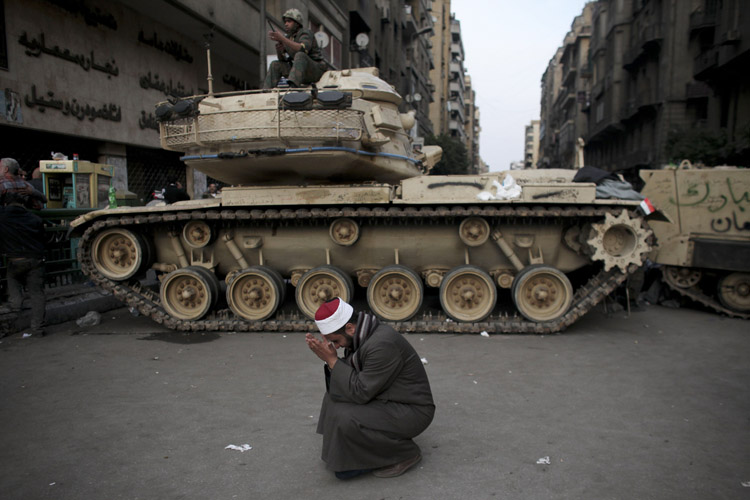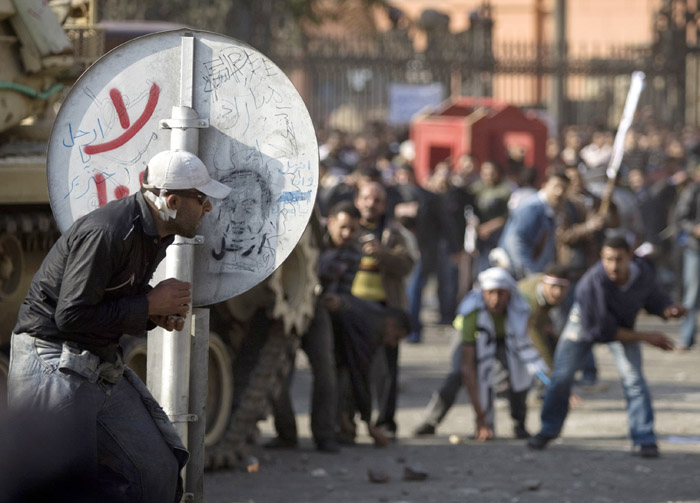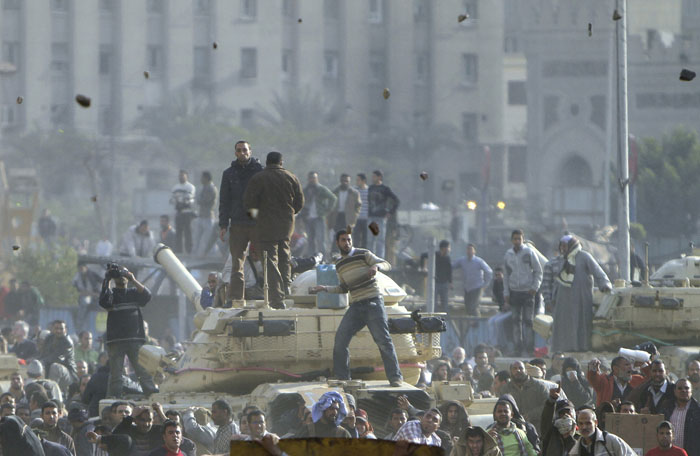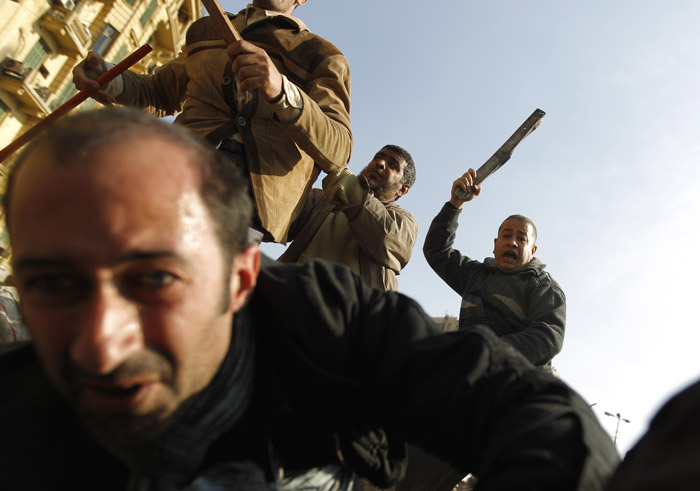CAIRO — Thousands of supporters and opponents of President Hosni Mubarak battled in Cairo’s main square today, raining stones, bottles and firebombs on each other in scenes of uncontrolled violence as soldiers stood by without intervening. Government backers galloped in on horses and camels, only to be dragged to the ground and beaten bloody.
At the front line, next to the famed Egyptian Museum at the edge of Tahrir Square, pro-government rioters blanketed the rooftops of nearby buildings, dumping bricks and firebombs onto the crowd below – in the process setting a tree ablaze inside the museum grounds.
On the street below, the two sides crouched behind abandoned trucks and hurled chunks of concrete and bottles at each other, and some government supporters waved machetes.
Bloodied anti-government protesters were taken to makeshift clinics in mosques and alleyways nearby, and some pleaded for protection from soldiers stationed at the square, who refused. Soldiers did nothing to stop the violence beyond firing an occasional shot in the air and no uniformed police were in sight.
“Hosni has opened the door for these thugs to attack us,” one man with a loudspeaker shouted to the crowds during the fighting.
The clashes marked a dangerous new phase in Egypt’s upheaval – the first significant violence between supporters of the two camps in more than a week of anti-government protests. Clashes began, first in the port city of Alexandria, just hours after Mubarak went on national television Tuesday night and rejected protesters’ demands he step down immediately. He defiantly insisted he would serve out the remaining seven months of his term.
That speech marked an abrupt shift in the deteriorating crisis. A military spokesman appeared on state TV today and asked the protesters to disperse so life in Egypt could get back to normal. That was a major turn in the attitude of the army, which for the past few days allowed protests to swell to their largest yet on Tuesday when a quarter-million peacefully packed into Tahrir Square.
Also, the regime for the first time today began to rally supporters in significant numbers to demand an end to the unprecedented protest movement calling for Mubarak’s removal.
Some 20,000 pro-government demonstrators held an angry but mostly peaceful rally across the Nile River from Tahrir, saying Mubarak’s concessions were enough and demanding protests end.
Having the rival sides on the streets is particularly worrying because there do not appear to be anywhere near enough police or military to control resurgent violence.
International concern was also mounting. The White House deplored the violence and called for restraint.
British Prime Minister David Cameron said Egyptian authorities must accelerate their political reforms and said that “if it turns out that the regime in any way has been sponsoring or tolerating this violence, that would be completely and utterly unacceptable.” German Foreign Minister Guido Westerwelle said the violence “raises the urgent question whether the political leaders of Egypt understand the need for rapid democratic reform.”
The violence began after nearly 10,000 anti-government protesters massed again in Tahrir on this morning, rejecting Mubarak’s speech as too little too late and renewing their demands he leave immediately.
In the early afternoon, around 3,000 Mubarak supporters broke through a human chain of protesters trying to defend the thousands gathered in Tahrir, according to an Associated Press reporter at the scene. They tore down banners denouncing the president, fistfights broke out as protesters grabbed Mubarak posters from the hands of the supporters and ripped them to pieces.
From there, it escalated into outright street battles as hundreds poured in to join each side. They tore up chunks of pavement and from grabbed ammunition from a nearby construction site, hurling stones, chunks of concrete and sticks at each, chasing each other.
At one point, a small contingent of pro-Mubarak forces on horseback and camels rushed into the anti-Mubarak crowds, trampling several and swinging whips and sticks to beat people. Protesters retaliated, dragging some from their mounts, throwing them to the ground and beating their faces bloody. The horses and camels appeared to be ones used by the many touts around Cairo who sell rides for tourists.
The main battle line next to the Egyptian Museum – the famed treasury of pharaonic antiquities and mummies – surged back and forth repeatedly for hours. Anti-Mubarak protesters held up sheets of corrugated metal ripped from the construction site as shields from the hail of stones. Some claimed that police IDs were found on several government supporters involved in the fighting.
Some tried to charge into the buildings where government supporters on the roofs were pelting them with stones, but they were stopped by plainclothes security forces at the entrances. Several firebombs from the roof landed in the museum grounds, setting a tree ablaze. Soldiers tried to put it out with a hose.
Protesters were seen running with their shirts or faces bloodied. Men and women in the crowd were weeping. Scores of wounded were carried to a makeshift clinic at a mosque near the square and on other side streets. Doctors in white coats rushed about with bags of cotton, mercurochrome and bandages. One man with blood coming out of his eye stumbled into a side-street clinic.
As night fell, protesters not engaged in the continued fighting knelt in prayers at the center of Tahrir Square, while others went to get food – a sign they plan to dig in for a long siege.
The army troops who have been guarding the square for days had been keeping the two sides apart earlier in the day, but when the clashes erupted they did not intervene. Most took shelter behind or inside the armored vehicles and tanks stationed at the entrances to the square.
Some anti-Mubarak protesters begged soldiers to help.
“Why don’t you protect us?” some shouted, but the troops replied they did not have orders to do so and told people to go home.
Many in the Tahrir rally – who for days have showered the military with love for its neutral stance – now accused the troops had intentionally allowed the attackers into the square.
“The army is neglectful. They let them in,” said 52-year-old protester Emad Nafa.
Today’s events could mean the regime has had enough, and that it and the military aim to ensure the end of the unrest after the 82-year-old Mubarak made the concession of announcing he would not run for a new six-year term in September elections.
As if to show the public the crisis was ending, the government began to reinstate Internet service after days of an unprecedented cutoff. State TV announced the easing of a nighttime curfew, which now runs from 5 p.m. to 7 a.m. instead of 3 p.m. to 8 a.m.
Mubarak supporters were on the street in significant numbers for the first time on Wednesday. Across the Nile River from the chaos in Tahrir Square, around 20,000 pro-government demonstrators held a rally in front of Mustafa Mahmoud Mosque in the upper-class neighborhood of Mohandiseen, after notices on state TV calling for attendance.
They waved Egyptian flags, their faces painted with the black-white-and-red national colors, and carried a large printed banner with Mubarak’s face as police officers surrounded the area and directed traffic. They cheered as a military helicopter swooped overhead.
Some appeared to be the sort of young toughs that the opposition accuses the regime of paying to be its fist in the streets.
But the large majority were middle-class families, some of whom said Mubarak’s concessions were enough and that they feared continued instability and shortages of food and other supplies if protests continue.
“I want the people in Tahrir Square to understand that Mubarak gave his word that he will give them the country to them through elections, peacefully, now they have no reason for demonstrations,” said Ali Mahmoud, 52, who identified himself as middle-class worker from Menoufia, a Nile Delta province north of Cairo.
The movement against Mubarak, meanwhile, was working to prevent any slipping in its ranks after the speech and resist any sentiment that the concession may have been enough.
One protest organizer said the regime was going all out to pressure people to stop protesting.
“Starting with the emotional speech of Mubarak, to the closure of banks, the shortage of food and commodities and deployment of thugs to intimidate people, these are all means to put pressure on the people,” said Ahmed Abdel-Hamid, a representative of the Revolutionary Committee, one of several youth groups that organized the protests.
The movement is fueled by deep frustration with an autocratic regime blamed for ignoring the needs of the poor and allowing corruption and official abuse to run rampant. Tuesday’s massive rally in Tahrir showed a large cross-section of Egyptian society.
Send questions/comments to the editors.






Success. Please wait for the page to reload. If the page does not reload within 5 seconds, please refresh the page.
Enter your email and password to access comments.
Hi, to comment on stories you must . This profile is in addition to your subscription and website login.
Already have a commenting profile? .
Invalid username/password.
Please check your email to confirm and complete your registration.
Only subscribers are eligible to post comments. Please subscribe or login first for digital access. Here’s why.
Use the form below to reset your password. When you've submitted your account email, we will send an email with a reset code.